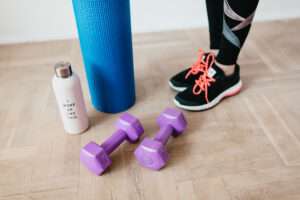Get Your Om on! The Health and Happiness Benefits of a Regular Yoga Practice
Yoga is a practice that has been used for thousands of years to improve physical and mental health. It’s a blend of physical postures, controlled breathing, meditation, and ethical conduct that work together to promote wellness and balance. Whether you’re new to yoga or a seasoned practitioner, this guide will help you understand the basics of this ancient practice and why it’s worth incorporating into your life.
What is Yoga and How Does it Work?
Yoga is a Sanskrit word that means “to join” or “to unite.” It’s a practice that aims to bring together the mind, body, and spirit to create a sense of balance and harmony. Yoga is based on the belief that the mind and body are interconnected and that by taking care of one, you can also improve the other.
The physical postures, or asanas, in yoga are designed to improve flexibility, strength, and balance. Controlled breathing, or pranayama, is used to calm the mind and regulate the breath. Meditation is used to quiet the mind and create a sense of inner peace. And ethical conduct, or yama and niyama, is used to promote positive relationships and attitudes towards others and oneself.

Quang Nguyen Vinh at Pexels
Different Types of Yoga
Yoga has evolved over the years and there are now many different styles to choose from. Here are some of the most popular styles:
- Hatha Yoga: Hatha is a general category that encompasses many different styles of yoga. It’s a gentle form of yoga that focuses on physical postures, breathing exercises, and meditation.
- Vinyasa Yoga: Vinyasa is a dynamic style of yoga that emphasizes fluid movement and breath-synchronized postures.
- Ashtanga Yoga: Ashtanga is a physically demanding style of yoga that follows a set sequence of postures and breathing exercises.
- Iyengar Yoga: Iyengar places a strong emphasis on proper alignment and the use of props such as blocks, straps, and blankets.
- Bikram Yoga: Bikram is a hot yoga style that is performed in a heated room. It follows a set sequence of 26 postures and two breathing exercises.
Benefits of Practicing Yoga
There are many physical and mental benefits to practicing yoga. Here are just a few of them:
- Reduced Stress and Anxiety: Studies have shown that practicing yoga can help to reduce stress and anxiety by lowering levels of the stress hormone cortisol.
- Improved Flexibility and Strength: Regular yoga practice can help to increase flexibility and strength in the muscles and joints.
- Increased Mental Clarity and Focus: Yoga can also help to improve mental clarity and focus by quieting the mind and improving concentration.
- Better Sleep: Yoga has also been shown to improve sleep by reducing symptoms of insomnia and promoting relaxation.
- Boosted Immune System: Regular yoga practice has been shown to improve the function of the immune system and reduce the risk of illness.
Who Can Practice Yoga and Precautions to Take
Yoga is a low-impact form of exercise that can be practiced by people of all ages and fitness levels. However, there are some precautions that you should take before starting a yoga practice.
If you have any medical conditions, it’s important to talk to your doctor before starting yoga. This is especially important if you have any pre-existing conditions such as high blood pressure, heart disease, or back problems. Your doctor can advise you on which types of yoga are best for you and any modifications you may need to make to your practice.
Tips for Back Pain: Your Guide to Causes, Prevention, and Relief
How Often and For How Long
You should practice yoga regularly to see the best results. Some people choose to practice every day, while others prefer to practice a few times a week. The frequency of your practice will depend on your goals and schedule, but it’s important to make it a consistent part of your routine.
As for how long, most yoga classes are around an hour long, but you can also practice at home for shorter periods of time. It’s recommended to start with 10-15 minute sessions and gradually increase the length of your practice as you become more comfortable with the postures.
What Equipment Do You Need to Start Practicing Yoga?
The great thing about yoga is that you don’t need much equipment to get started. However, here are a few items that you may find helpful:
- A yoga mat: A yoga mat provides cushioning for your joints and helps to prevent slipping.
- Comfortable clothing: Wear clothing that allows you to move freely and is comfortable to wear for extended periods of time.
- Props: Props such as blocks, straps, and blankets can help to modify postures and make them more accessible.

Karolina Grabowska at Pexels
Finding a Qualified Yoga Teacher or Studio
If you’re new to yoga, it’s recommended to find a qualified yoga teacher or studio to guide you through the postures and ensure that you’re practicing safely. Look for a teacher or studio that aligns with your goals and values and make sure to ask about their credentials and experience.
What to Expect During Your First Yoga Class
Your first yoga class can be intimidating, but it’s important to approach it with an open mind and a willingness to learn. Expect to be in a room with others who are also new to yoga and don’t be afraid to ask questions or seek clarification from the teacher. The teacher will guide you through the postures and breathing exercises, and you’ll likely be given the opportunity to rest in between postures.
Making Yoga a Regular Part of Your Routine
Once you’ve attended a few classes, it’s important to make yoga a regular part of your routine. This can be as simple as setting aside a specific time each day for your yoga practice or incorporating yoga into your existing exercise routine. You can also join a local yoga community or attend classes regularly to stay motivated and continue your growth as a practitioner.
Risks Associated with Practicing Yoga and How to Minimize Them
While yoga is generally considered to be a safe form of exercise, there are some risks associated with practicing yoga, especially if you have pre-existing medical conditions or if you push yourself too hard. To minimize these risks, it’s important to listen to your body and not push yourself beyond your limits. If you experience pain or discomfort during your practice, stop and seek medical attention if necessary.
In conclusion, yoga is a practice that offers numerous physical and mental benefits. By incorporating yoga into your life, you can improve your flexibility, strength, mental clarity, and overall health. Whether you’re new to yoga or a seasoned practitioner, this guide will help you understand the basics of this ancient practice and why it’s worth incorporating into your lifestyle.
You may also like Yoga Through the Ages: Unpacking the Power of the Asanas and Mindfulness Meditation: Unlocking the Power.
FAQ
Q: What are the key benefits of a regular yoga practice?
A: Yoga improves flexibility, strength, balance, posture, and cardiovascular health, while reducing stress and promoting mental clarity.
Q: How often should I practice yoga for optimal results?
A: Aim for a minimum of 3 sessions per week, ideally with each session lasting 45-60 minutes, to experience lasting benefits.
Q: Can yoga help with stress relief and mental health?
A: Yes, yoga incorporates mindfulness and deep breathing techniques that can reduce stress, anxiety, and depression while enhancing overall mental health.
Q: Is yoga suitable for all ages and fitness levels?
A: Absolutely! Yoga offers various styles, poses, and modifications to accommodate all levels of fitness, age groups, and personal needs.
Q: How do I choose the right yoga style for me?
A: Research different styles, such as Hatha, Vinyasa, or Yin, and attend introductory classes or workshops to find the best fit for your goals and preferences.
Q: What equipment do I need for a yoga practice?
A: A yoga mat, comfortable clothing, and optional props like blocks, straps, or a bolster will help you get started on your yoga journey.
keywords:Mental,Postures,Namaste,Health,Clothing,yoga,Benefits,Mental clarity,Asana,Props,Warrior pose,Tree pose,Equipment,Mats,wellness,Zen zone,Inner peace,Downward dog,Fitness,yoga benefits, yoga health benefits, yoga and happiness, yoga for physical health, yoga and mental health, yoga poses for happiness, benefits of yoga for stress relief, how to stay healthy with yoga, the power of yoga for physical and mental health, the importance of yoga in our life, importance of yoga in daily life, how to use yoga









